中国翻译简史
中西方翻译简史(包含中西方翻译大家简介)全

“英最伟大译著”
路德(Luther) (1483-1546)
• 翻译必须采用人民的语言。 • 翻译必须注重语法和意思的联系。译者不能与语法背道而
驰,但更应该注意意思的理解和表达。 • 翻译必须遵循意译七原则。 • 翻译必须集思广益。
➢ 大致分为四个时期: 东汉至西晋(草创时期)
➢
东晋到隋(发展时期)
➢
唐代(全盛时期)
➢
北宋(结束时期)
东汉至西晋(草创时期)的佛教翻译:
• 始于东汉桓帝建和二年(公元148)。
• (公元148-316年) • 主要是外籍僧人和华籍胡裔僧人,翻译主要靠直译,甚至是“死译”、
“硬译”,采取口授形式,因此可信度不高。 • 最早的翻译家有两人:安清(即安世高)和娄迦谶(又名:支娄迦谶,
奈达(Nida)
• 理论原则:
•
语言的共性---可译性;
•
差别在于对语言的需求
• 翻译的性质
• 翻译的功能
• 语义分析
翻译的性质
: • Nida translating consists in reproducing in the receptor
language the closest natural equivalent of the source-language message, first in terms of meaning and secondly in terms of style.
传统方式,发展机器翻译,成为新时期翻译发展一个重要 的标志。
费道罗夫
• 翻译理论首先“需要从语言学方面研究”, • (翻译理论由翻译史、翻译总论和翻译分论三部分组成); • 费道罗夫的《翻译理论概要》一书从语言学角度对翻译理论进行了分
中外翻译简史

中外翻译简史一、中国翻译简史从现有史实来看,中国翻译史始于东汉末年安世高的佛经翻译。
大体经历了五个高潮。
1. 佛经翻译(公元148年至1111年)佛经翻译始于东汉,盛于唐朝,式微于北宋,元以后为尾声。
起始阶段(公元148—316年)的译家及译作主要有:安世高,译籍30部,41卷,现存22部,26卷;支谦,译有《大明度无极经》。
兴盛阶段(公元317—617年)的译家及译作主要有:释道安,编有《众经目录》,在《摩诃钵罗若波罗蜜经钞序》中提出著名的“五失本、三不易”理论,倾向于直译;鸠摩罗什,共译74部,现存39部,如《妙法莲华经》、《大智度论》、《金刚经》等,倾向于意译;真谛,共译64部,现存26部,如《摄大乘论》等;彦琮,共译23部。
全盛阶段(公元618—906年)的译家及译作主要有:玄奘,通称“三藏法师”,629年前往印度那烂陀寺求学,带回梵文经典657部,十九年中共译经论75部,1335卷,主持了译场,提出“既须求真,又须喻俗”和“五不翻”原则。
2、明末清初科技翻译主要是耶稣会士和中国士大夫相结合进行的,汉译17世纪西方自然科学,古希腊哲学、科学等。
从事或组织翻译的代表人物有:马礼逊(Robert Morrison)、利玛窦(Matteo Ricci)、汤若望(Jean Adam Schull von Bell)、林则徐、魏源、李善兰、徐光启、徐寿等,主要译作有《几何原本》、《泰西水法》、《奇器图说》、《四洲志》、《西艺知新》及续编等。
另外,还设有我国最早的培养翻译人才的外语学校——四夷馆(明代),创办了同文馆、京师译学馆、江南制造总局翻译馆、墨海书馆、益智书会、文会馆、广学会等翻译编译机构。
3、清末民初的社科、文学翻译清末民初的社科翻译属严复最为著名。
严复(1854—1921),福建侯官(今福州)人,字几道。
译西学颇多,影响深远,如:《天演论》(T. Henry Huxley, Evolution and Ethics and Other Essays),《原富》(Adam Smith, Inquiry into theNature and Cause of the Wealth of Nations),《群学肄言》(H. Spencer, Study of Sociology),《群己权界论》(John Stuart Mill, On Liberty),《社会通诠》(E. Jenks, History of Politics),《法意》(C.D.S. Montesquien, Spirit of Law),《穆勒名学》(John Stuart Mill, System of Logic),《名学浅说》(W.S. Jevons)等。
中国翻译简史

林语堂
• 中国现代著名作家,学者、翻译家、语言 学家、新道家代表人物,1895年生于福建 漳州平和县坂仔镇一个基督教牧师家庭, 原名和乐,后改名玉堂,又改名为语堂, 早年留学美国、德国,获哈佛大学文学硕 士,莱比锡大学语言学博士。回国后分别 在清华大学、北京大学、厦门大学任教。 林语堂于1940年和1950年先后两度获得诺 贝尔文学奖提名。
中国译历史简介
A general introduction to the history of translation in China
•
中国的翻译史有史籍记载的已长达三千余 年,早在史前三皇五帝时代就存在翻译活 动,一般认为“五四"以前,中国翻译史上 出现过三次翻译高潮。
三次翻译高峰(three translation peaks)
• 1)东汉--唐宋时期 • 2)隋唐--明末清初 • 3)鸦片战争--五四运动
第一次翻译高峰期
• 佛经翻译(sutra translation)
• 释道安首创译场制度,提出著名"五失本,三不易"理论, 他主张严格的直译 • 天竺人鸠摩罗什创立了一整套译场制度,开集体翻译, 倾向于意译,注重文质结合,既忠实与原文的神情,能 “以实出华”,他反对译经时用“格义”。 • 玄奘(唐朝佛经翻译达到顶峰),他不但把佛经翻译成汉 文,而且把老子著作的一部分译成了梵文,成为了第一个 把汉文著作向国外介绍的中国人,制定了“五不翻”的原 则,即:秘密故、含多义故、无此故、顺古故以及生善故。 译文中运用的种种技巧:补充法、省略法、变位法、分合 法、译名假借法、代词还原法。
第二次翻译高峰期
• 科技翻译(science and technology translation) • 代表人物:中国科学家徐光启和意大利人 利玛窦,合作翻译《几何原本》前六卷。 • 这一阶段主要是外国人口译,中国人笔述, 国人选择译品的余地不大,译者对翻译理 论技巧知之不多,所以译作大都有“文义 难精”之弊。
中西翻译简史和翻译的标准

神似(傅雷);(similarity in spirit)
一当力求其易解,一则保存原作的丰姿(鲁迅);
信达雅(严复);(faithfulness, expressiveness, elegance)
化境(钱钟书);(sublimation) “文学翻译的最高理想可以说是‘化’。把作品从一国文字转变成另一国文字, 既不能因语文习惯的差异而露出生硬牵强的痕迹, 又能完全保存原作的风味, 那就算得入于‘化境’ ”
翻译的标准 The Criteria of Translation
翻译标准就是指翻译实践时译者所遵循的原则,也是翻译批评家批评译文时必须遵循的原则。
01
02
Theories of Chinese scholars’ 中国:案本-求信-神似-化境
“文”“质”之争(实际为“意译”与“直译”之争)(佛经翻译);
佛经翻译时期(东汉至元末,2世纪至16世纪) 特点:时间长;译量大;译者多为佛教高僧;以梵汉互译为主
释道安: “五失本,三不易”,主张直译 鸠摩罗什:主张意译;第一次主张译者署名;组织翻译《金刚经》《法华经》等300余种佛经,译著有“天然西域之语趣”,表达了原作的神情。
我国佛经三大翻译家:鸠摩罗什、真谛和玄奘
“倘若拿河流来作比,中华文化这一条长河,有水满的时候,也有水少的时候,但却从未枯竭。原因就是有新水注入。注入的次数大大小小是颇多的。最大的有两次,一次是从印度来的水,一次是从西方来的水。而这两次的大注入依靠的都是翻译。中华文化之所以能常葆青春,万应灵药就是翻译。翻译之为用大矣哉!”(季羡林,孙,P3)
社会科学及文学翻译时期 (清末至“五四”时期)
林纾:《巴黎茶花女遗事》、《黑奴吁天录》、《王子复仇记》等文学作品
中国翻译简史
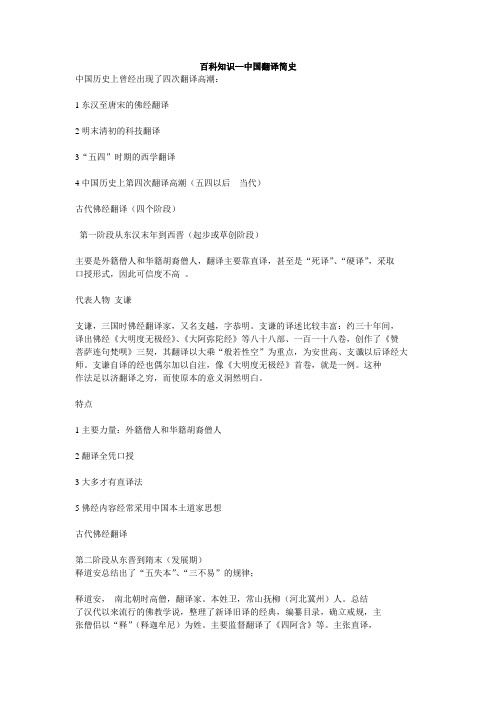
百科知识—中国翻译简史中国历史上曾经出现了四次翻译高潮:1东汉至唐宋的佛经翻译2明末清初的科技翻译3“五四”时期的西学翻译4中国历史上第四次翻译高潮(五四以后---当代)古代佛经翻译(四个阶段)第一阶段从东汉末年到西晋(起步或草创阶段)主要是外籍僧人和华籍胡裔僧人,翻译主要靠直译,甚至是“死译”、“硬译”,采取口授形式,因此可信度不高。
代表人物支谦支谦,三国时佛经翻译家,又名支越,字恭明。
支谦的译述比较丰富:约三十年间,译出佛经《大明度无极经》、《大阿弥陀经》等八十八部、一百一十八卷,创作了《赞菩萨连句梵呗》三契,其翻译以大乘“般若性空”为重点,为安世高、支谶以后译经大师。
支谦自译的经也偶尔加以自注,像《大明度无极经》首卷,就是一例。
这种作法足以济翻译之穷,而使原本的意义洞然明白。
特点1主要力量:外籍僧人和华籍胡裔僧人2翻译全凭口授3大多才有直译法5佛经内容经常采用中国本土道家思想古代佛经翻译第二阶段从东晋到隋末(发展期)释道安总结出了“五失本”、“三不易”的规律;释道安,南北朝时高僧,翻译家。
本姓卫,常山抚柳(河北冀州)人。
总结了汉代以来流行的佛教学说,整理了新译旧译的经典,编纂目录,确立戒规,主张僧侣以“释”(释迦牟尼)为姓。
主要监督翻译了《四阿含》等。
主张直译,不增不减,只做词序调整。
翻译佛经在五种情况下会失去本来面目,有三件事决定了译事是很不容易的,因此必须慎之又慎。
彦琮在其论着《辩正论》中提出了翻译要例“十条和对译者的要求“八备””彦琮(557—610年),俗姓李,邢台隆尧县双碑人,隋代著名高僧,他精通梵文,也是我国佛教史上屈指可数的佛经翻译家和佛教著作家。
《辩正论》里翻译要例八备十条:就是对做翻译人的具体要求和翻译要求。
鸠摩罗什开始提倡意译;鸠摩罗什(梵语Kumārajīva )(公元344 ~ 413 年),音译为鸠摩罗耆婆,又作鸠摩罗什婆,简称罗什。
其父名鸠摩罗炎,母名耆婆,属父母名字的合称,汉语的意思为“童寿”。
中国翻译简史

中国翻译简史:中国翻译史有史籍记载的已长达三千余年,早在史前三皇五帝时代就存在翻译活动。
(中国翻译史话)一般认为,“五四”以前,中国翻译史上出现过三次翻译高潮:第一次高潮始于东汉至唐宋时期,佛经翻译盛行。
据史家考证,最早的佛典汉译始于东汉桓帝年间的安世高,他译了《安般守意经》等三十五部佛经,开后世禅学之源,其译本“义理明晰,文字允正,辩而不华,质而不野”(梁皎慧,高僧传),但其主要偏于直译。
继安世高之后译经的是支娄迦谶,其所译经典,译文流畅,但为了力求保全原来面目,“辞质多胡音”,即多音译。
中国佛经翻译史上,一直存在“质朴”和“文丽”两派。
继安世高、支娄迦谶之后的又一译经大师支谦“颇从文丽”,开创了不忠实原著的译风,对三国至西晋的佛经翻译产生了很大的影响。
翻译中的“会译”(即将几种异译考校对勘,合成一译)体裁,以及用意译取代前期的音译.也均由支谦始。
到了前秦时代,佛经翻译由私人事业转入了译场翻译,释道安在朝廷的支持下首创译场制度,采用“会译”法来研究翻译。
他主张严格的直译,并总结汉末以来的译经经验,提出了著名的“五失本,三不易”理论,指出五种容易使译文失去原来面目的情况和三种不容易处理的情况。
释道安晚年时请来天竺人鸠摩罗什,鸠摩罗什继道安之后创立了一整套译场制度,开集体翻译、集体审校的先河。
罗什倾向意译,其译经重视文质结合,既忠实于原文的神情,读来又妙趣盎然,能“以实出华”,传达原经的文体美和修辞美。
他反对前人译经时用“格义”(用中国哲学的传统概念比附和传译佛学概念)的方法,创立了一整套佛教术语。
隋唐时期是我国翻译事业高度发达的时期。
隋代历史较短,译经不多。
其中彦琮提出“八备”,即做好佛经翻译工作的八项条件,在我国译论史上最早较全面地论述了翻译活动的主体——翻译者本身——的问题。
到了唐代,佛经翻译事业达到顶峰。
出现了以玄奘为代表的大批著名译者。
玄奘即通称的“唐三藏”或“三藏法师”,他于贞观二年(公元628年)远度印度学佛求经.十七年后归国。
中国翻译简史3

中国翻译简史31840年鸦⽚战争后中国沦为半殖民地半封建社会。
⾃鸦⽚战争失败后,⼀批忧国忧民的先进⼈⼠⾯对民族危亡,图⾃强、谋复兴,积极推动翻译和传播西⽅⾃然科学和哲学、社会科学知识,培养早期翻译⼈才,在近代翻译史上开创了西学翻译的⾼潮,使中国近代向西⽅国家寻求真理的历程进⼊了⼀个新的阶段。
鸦⽚战争的失败促使清政府在19世纪60年代开始推⾏洋务运动,促成西⽅的科学技术再⼀次传⼊中国。
张之洞的“中学为体,西学为⽤”,成为晚清新式知识分⼦最典型的西学观点。
洋务派认为学到西⽅的坚船利炮之技艺,就能“师夷之长技以制夷”。
洋务派兴办新式学堂,官派留学⽣,培养了⼤批学者型翻译家。
从19世纪60年代起,开办讲习外语、军事、⼯艺的新式学堂,如京师同⽂馆(1862)、上海⼴⽅⾔馆(1863) 、⼴州同⽂馆(1864), 江南制造局翻译官(1867)等。
同时派遣⼤批留学⽣赴英、法、美、德等国学习军事、技术、⾃然等科⽬。
设译书局、翻译西籍,传播西⽅科学,沟通中西⽂化。
清朝最早创建的翻译馆是俄罗斯⽂馆,后在京师同⽂馆、天津⽔师学堂、上海江南制造局等校均创设译书局(翻译学馆),专门从事西籍翻译,有组织、有分⼯、系统译介西学的精华。
中外合作译书,发挥各⾃优势,造就⼀流科技翻译家。
各译书局聘请⼀批外国来华教会⼈⼠和汉学家担任教习,或主持馆务,并与中国教习合作,从事西学翻译⼯作,对清末的科学技术发展和社会改⾰起到了积极的促进作⽤同时早就了⼀批中国⼀流科技翻译家。
他们的历史功绩和翻译成就为后⼈敬仰。
其中杰出的代表有李善兰、华蘅芳、徐寿。
),清代杰出的数学家,科技翻译家,中国近代科学的先驱。
他⾃幼通晓数学,15岁⼜习《⼏何原本》。
1852年在上海客居期间,结识英国⼈伟烈亚⼒等⼈,与他们⼀起探讨中西学术,并与伟烈亚⼒合作续译《⼏何原本》后九卷,于1856年译成,翌年出版,最终完成徐光启未竟之业。
还译有英国数学家棣么⽢《代数学》13卷,美国数学家罗密⼠的《代微积分拾级》18卷,使西⽅近代符号代数学、解析⼏何学、微积分学第⼀次传⼊我国。
中国翻译简史

中国翻译简史Chapter1中国翻译简史Three peaks of translation in history1)the translation of Buddhist classics: the first peak支谦,鸠摩罗什,真谛,玄奘2)the translation of books on science and technology: the second peak徐光启(科学译祖),李之藻3)the translation of western classics: the third peak1,严复信faithfulness,意义不背原文达expressiveness,不拘泥于原文的形式,以最准确、最生动的译文把原文的意思表达出来雅elegance,译文本身的古雅《天演论》《法意》《原富》《名学》》《群己权界论》2,梁启超学术界的鸿儒用资产阶级思想方法研究中国历史3,林纾儆醒人心,反帝救国;开创中国翻译事业的先行者和奠基人《巴黎茶花女遗事》,《王子复仇记》Translation in contemporary China: from 1919 to 19494, 鲁迅对中国近代文学翻译史的重要贡献(一)开辟了近代中西文化交流史上具有重要意义和影响的第二潮流(二)我国近代翻译史上的重大变革翻译思想(一)“易解、丰姿”双重标准(二)“以直译为主,意译为辅”与“以信为主,以顺为辅”5,瞿秋白大众化原则,“绝对正确,绝对白话文”的思想翻译《国际歌》6,郭沫若重译家责任, 重视译者主体性;强调的翻译动机7,林语堂翻译是一门艺术;翻译的标准:忠实、通顺和美8,朱光潜西方美学翻译Translation in contemporary China: from 1949 to the present time9, 茅盾“神韵说”;创造性翻译论10,傅雷神似说强调原文精神和韵味的重现11,钱钟书化境论,强调译者流畅、地道的本族语12,王佐良以诗译诗;为读者着想, 译文要可靠、可读13,许渊冲美化之艺术﹑创优似竞赛;文学翻译是艺术;以诗译诗;贯彻再创作论春眠不觉晓,处处闻啼鸟。
中国翻译简史
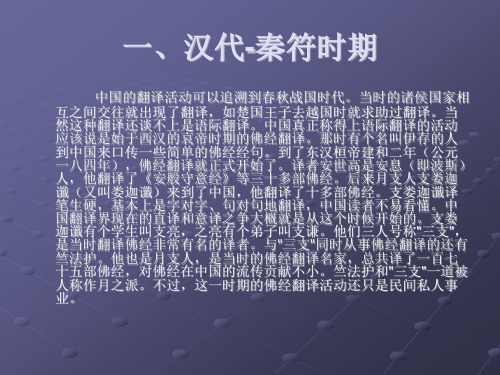
到了宋代,佛经翻译已远不如唐初的极盛时期。在北 宋的乾德开宝年间,宋太祖曾派人西去求经,印度也派名 僧东来华夏传法。宋太祖也曾在开封的太平兴国寺内兴修 了译经院,专事佛经翻译。虽译场组织极其完备,译经种 数几乎接近唐代,但质量却不如唐代。当时有名的僧侣译 者主要有天息、法护等人。在翻译理论方面颇有贡献的要 数赞宁(俗姓高,今浙江德清人)。他曾归纳了以往译经 的各种情况,提出了解决翻译过程中各类矛盾的六种办法。 这是对我国唐代翻译理论的继续和发展,是我国翻译论库 中的宝贵财富。到了南宋,由于社会动荡等原因,佛经翻 译已是寥寥无几,史书的记载中无一例翻译。在其后的元 代,统治者曾下昭拔合恩巴、管主八等人翻译佛经,但译 作只有十几部,翻译理论方面的探讨更是无从谈起。翻译 事业基本处于停滞状态。
严复(1954.1.18-1921.10.27)是我国清末新兴资产
阶级的启蒙思想家。他从光绪二十四年到宣统三年(公元 1898-1911)这三十年间翻译了不少西方政治经济学说, 如赫胥黎(T.H. Huxley)的《天演论》(Evolution and Ethics and Other Essays)、亚当﹒斯密(A.Smith)的 《原富》(An Inquiry into the Nature and Cause of the Wealth of Nations)﹑孟德斯鸠(C.L.S. Montesquieu) 的《法意》(L'esprit des Lois)、斯宾塞尔(H.Spencer) 的《群学肆言》(On Liberty)、甄克思(E.Jenks)的 《社会通诠》(A History of Politics)等。严复每译一
一、汉代-秦符时期
中国的翻译活动可以追溯到春秋战国时代。当时的诸侯国家相 互之间交往就出现了翻译,如楚国王子去越国时就求助过翻译。当 然这种翻译还谈不上是语际翻译。中国真正称得上语际翻译的活动 应该说是始于西汉的哀帝时期的佛经翻译。那时有个名叫伊存的人 到中国来口传一些简单的佛经经ห้องสมุดไป่ตู้。到了东汉桓帝建和二年(公元 一八四年),佛经翻译就正式开始了。译者安世高是安息(即波斯) 人,他翻译了《安般守意经》等三十多部佛经。后来月支人支娄迦 谶(又叫娄迦谶)来到了中国,他翻译了十多部佛经。支娄迦谶译 笔生硬,基本上是字对字、句对句地翻译,中国读者不易看懂。中 国翻译界现在的直译和意译之争大概就是从这个时候开始的。支娄 迦谶有个学生叫支亮,之亮有个弟子叫支谦。他们三人号称"三支", 是当时翻译佛经非常有名的译者。与"三支"同时从事佛经翻译的还有 竺法护。他也是月支人,是当时的佛经翻译名家,总共译了一百七 十五部佛经,对佛经在中国的流传贡献不小。竺法护和"三支"一道被 人称作月之派。不过,这一时期的佛经翻译活动还只是民间私人事 业。
第4讲中国翻译简史之明末清初科技翻译分解

The Society of Jesus
The Society of Jesus (Latin: Societas Iesu, S.J., SJ or SI) is a Christian male religious order of the Roman Catholic Church. The members are called Jesuits. The society is engaged in evangelization and apostolic ministry in 112 nations on six continents. Jesuits work in education (founding schools, colleges, universities and seminaries), intellectual research, and cultural pursuits. Jesuits also give retreats, minister in hospitals and parishes and promote social justice and ecumenical dialogue.
利玛窦(Matteo Ricci,1552—1610)
利玛窦(Matteo Ricci,1552—1610)
意大利耶稣会传教士,基督教在中国传教的开拓 者之一,也是第一位阅读中国文学并对中国典籍 进行钻研的西方数学、地理等 科学技术知识。既是传教士,也是汉学家、翻译 家。 1583年来到中国,为了结交中国士大夫,他在住 所里摆放从欧洲带来的自鸣钟、三棱镜、浑天仪 等,并悬挂世界地图,吸引来访者。
利玛窦(Matteo Ricci,1552—1610)
2-中国翻译简史

▪ 严复根据自己的翻译实践,参照古代翻译佛经的经验,在 天演论 卷首的译例 言 中提出了著名的“信、达、雅”翻译标准。(一八九八年)
▪ 《马氏文通》作者马建忠一八九四年提出了善译标准,包括三大要求:一、译 者要对两种语言素有研究,熟知彼此的异同;二、弄清原文的意义,精神和 语气,把它表达出来;三、译文与原文毫无出入。
经》。他所译的经文变而不滑,质朴而不粗俗,因而被称为直译的鼻祖。
* 十六国时期,前秦国王苻坚热心提倡佛教,并将其奉为国教。他 请来释道安成立了专门的译经机构“译场”,道安推荐并组织众多 译经大师从事翻译工作,其中鸠摩罗什是最知名、成就最大者。他 共译了《金刚经》、《法华经》等39部,313卷。译著文字优美、畅 达,忠实地再现了原著的道理,具有“天然西域之情趣”。鸠摩罗 什开了意译的先锋,译文妙趣盎然,为我国翻译文学奠定了基础。他 还进一步完善了译场,原来的译场只有“口授、传言、笔授”三个 环节,他增加了“校对”这一环节。译完作品之后写上译者的名字 一也是从他开始的。梁启超评价他所译经文为“秦梵两娴,诵写自 在,信而后达,达而后雅”。
▪ 鲁迅译《毁灭》、《死魂灵》等。他的翻译标准的主要观点是:“凡是翻译,必须兼顾两
面,一当然力求其易解,一则保存原作的丰姿。”反对胡译乱译,主张“宁信而不顺”的原 则。他主张直译是为了照顾输入新表现法和保持原作的风貌,不同于“死译”。
▪ —— 一九四九年随着新中国的成立,翻译事业也得到了解放,翻译工作在党的领 导下不断迅速发展,取得了巨大成就,在理论方面也日益充实完善。
《译例言》中提出了著名的“信、达、雅”翻译标准。他写道;“译事三 难:信、达、雅。求其信,已大难矣!顾信矣,不达,虽译,犹不译也, 则达尚焉。”作为翻译标准,这三个字的提法简明扼要,层次分明, 主次突出。因此尽管人们对这三个字尤其是对“雅”字的解释存在着 分歧,但许多年以来,“信、达、雅”始终没有被我国翻译界所废弃, 有些翻译工作者仍然沿用这三个字作为当今的翻译标准。总之,严复 对我国翻译事业是有很大贡献的。
中国翻译史概述
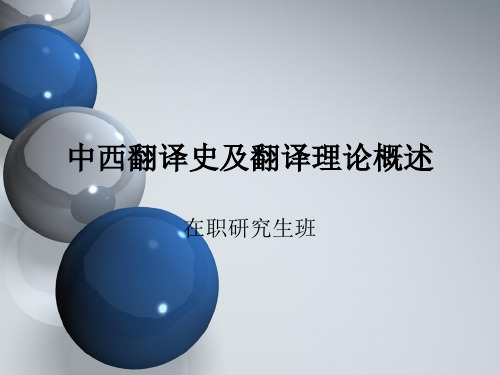
1. 中国翻译简史
• 周朝的翻译
• 寄、象、狄鞮、译
五方之民,言语不通, 嗜欲不同。达其志,通 其欲,东方日寄,南方日 象,西方日狄鞮, 北方 日译。
• 其他称呼:舌人、反舌、行 人
• 翻译的来历 • 越人歌:我国历史上第一篇诗歌
中国翻译简史
·
• 秦始皇统一秦中的国翻译,统一 文字,
在此过程中应该会有很 多翻译活动,但至今未 有很多著述。
• 翻译理论方面:
• 严复的信达雅:《天演论·译例言》信、达 、雅,Faithfulness, Expressiveness and Elegance
• 梁启超翻译批评、翻译史的贡献:《西学 书目表》,《论译书》、《译印政治小说 序》 ,《佛教之初输入》、《翻译文学与 佛点》、《中国近三百年学术史》
• 玄奘提出了佛经翻译中著名的“五不 翻”的原则,并为译经者进行了十一 种详细的分工。
际
的
翻
• 西方传教士与中国译士大夫
• •
明 利清 玛的 窦宗Ma教tt、eo科Ri技cc活翻i 译
动 • 利玛窦是他的中文名字,号西泰,
又号清泰、西江。在中国颇受士大
夫的敬重,尊称为“泰西儒士” 。
• 在中国建立第一所天真教堂(1582 )
• 佛经翻译的发展阶段 • 释道安:五失本,三不易 • 鸠摩罗什,意译 • 彦琮: 《辨证论》
译者的条件:八备
时 期
·
• 特点
唐
• 译 语者言多和为佛汉理人 。,朝精通梵汉两种
• 有计划地进行佛经翻译。
• 译场制度更加完善。。
• 译文质量好,忠实性较高。
• 这一阶段的译经活动达到顶峰,出现了玄 奘、不空、义净等著名的僧人译经家
第一讲 中国翻译简史
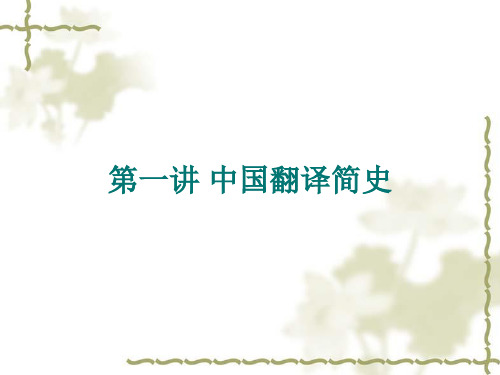
东汉至西晋(草创时期)的佛教翻译:
❖ 支谦 三国时佛经翻译家。东汉末年,避乱入吴,博览群 书,通晓六国语言,才学深澈,内外通备,得到孙 权赏识。
❖ 有意识地变通原文,删减原本中繁复的表达,减少 胡音在译本中的比重,改‘胡音’为汉意,减少胡 语即音译在译本中的比重,也就是用意译取代音译。
❖ 其译文:文质调和。
第一讲 中国翻译简史
中国翻译简史
我国有文字记载的翻译事业有约两千年的历史。 不同学者对我国的翻译史有不同的划分。
马祖毅(陈福康,2005:v) ):五四运动 (1919年)前有三次翻译高潮:从东汉到宋的佛经翻 译;明末清初的科技翻译;鸦片战争(1840年)以后 的西学翻译。
陈福康( 2005:v ):古代、晚清、民国、1949年 以后四个时期。
重 “文”
《Once Upon a Time in China》
重 “质”
《Huang Feihong》
《纵横四海》
《Once a Thief》
《Cross Four Oceans 》
《 Blood and Sand 》
《碧血黄沙》
《血与沙》
《 One Flew over the Cuckoo’s Nest 》 《飞越疯人院》
唐代(全盛时期)的佛经翻译
❖ 玄奘
在译经的数量和译论贡献方面 皆无人出其左右。也是我国历 史上促进中印友好和文化交流 的首屈一指的人物。 ❖ 河南人,唐太宗贞观三年从长 安出发,西出敦煌,四年后展 转到达印度,至贞观十九年回 到长安。往返十七年,行程五 万里,历尽艰辛,使他成为一 个传奇人物。
❖ 玄奘带回佛经650余部,数量之多,品类之 富,空前未有。谢绝官职,献身译经事业。
❖ 支谦所作《法句经序》,一般认为是现存最早带 有佛经翻译理论性质的文章。
中国翻译简史

鉴赏
• • • • • • • • • • • • • 这几年中国发生了很大的变化。 1. These years China has taken place great changes. 2. Great changes have taken place in China these years. 3. China has witness great changes these years. 我们都尊敬系里经验丰富的老教师。 1. We all respect the experienced aged teachers in our department. 2. We all respect the experienced senior teachers in our department. 我们的基础教育相对薄弱. 1. Our fundamental education is quite insubstantial. 2. Our elementaryl education is quite insubstantial. 昨天晚上我们玩得很愉快。 1. We played very pleasantly last night. 2. We enjoyed ourselves very much last night.
东晋道安: 五失本,三不易;
• “译胡为秦,有五失本也。一者,胡语尽倒而使从秦,一失本也; • 二者,胡经尚质,秦人好文,传可众心,非文不可,斯二失本也; • 三者,胡语委悉,至于咏叹,叮咛反复,或三或四,不嫌其烦,而今裁斥,三失 本也; • 四者,胡有义说,正似乱辞,寻说向语,文无以异,或千、五百,刈而不存,四 失本也; • 五者,事已全成,将更傍及,反腾前辞,已乃后说,而悉除此,五失本也。 • 然《般若经》,三达之心,覆面所演,圣必因时,时俗有易,而删雅古,以适今 时,一不易也; • 愚智天隔,圣人叵阶,乃欲以千岁之上微言,传使合百王之下末俗,二不易也; 阿难出经,去佛未久,尊者大迦叶令五百六通,迭察迭书;今离千年,而以近意量 裁,彼阿罗汉乃兢兢若此,此生死人而平平若此,岂将不知法者勇乎?斯三不 易也。”
中西翻译简史及翻译的标准解读
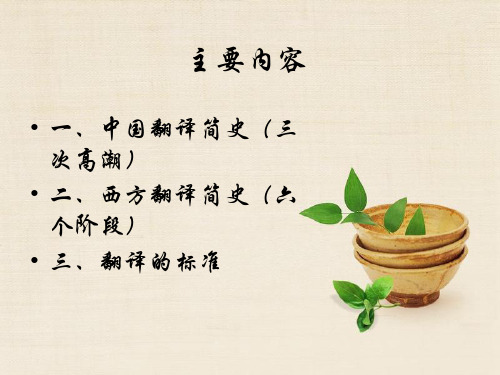
• 一、中国翻译简史(三 次高潮) • 二、西方翻译简史(六 个阶段) • 三、翻译的标准
一、中国翻译简史
• “文化(文明)的发展可以分为五个阶 段:诞生、成长、繁荣、衰竭、消逝。 这是一个普遍规律,任何文化都不能 永存。然而,中国文化似乎是个例外。 五千年来,虽然经历了不少波折,走 过了不少坎坷的道路,但是中华文化 却一直没有消逝。”
★释道安: “五失本,三 不易”,主张直译 ★鸠摩罗什:主张意译; 第一次主张译者署名; 组织翻译《金刚经》 《法华经》等300余种佛 经
★彦琮:译人“八备”; 第一个将汉文译成梵 文;中国第一部翻译 理论书《辨证论》 ★玄奘:“既须求真, 又须喻俗”;将《道 德经》译成梵文;运 用补充法、省略法等 翻译技巧
2.西方自然科学翻译 (16世纪至18世纪中叶,明末至清朝中期)
• 特点:译者多为西方 传教士以及少数从事 科学技术研究或对科 学技术感兴趣的中国 士大夫;翻译西方自 然科学,如数学、化 学、机械方面的书籍
• 徐光启(明):数学家,农学 家,《几何原本》前六卷(意 大利传教士利玛窦合译) • 李善兰(清):数学家,《几 何原本》后九卷(与英国人伟 烈亚力合译)、《代数学》、 《代微积拾级》
Байду номын сангаас
★京师同文馆(1862 年,北京、上海、 广州) ★江南制造局翻译 馆(1865年,上海)
鲁迅、郭沫若、林语堂、巴金、梁 实秋、徐志摩、郁达夫、钱钟书 朱生豪、傅雷、董秋斯、张谷若等
英文译作: 《镜花缘》 《老残游记》 《浮生六记》
• 郭沫若:《浮 士德》《少年 维特的烦恼》 等 • 傅雷:《高老 头》、《欧也 妮· 葛朗台》 • 梁实秋、朱生 豪:莎士比亚 全集
• 有关翻译的书面记载: • 周朝 设有专司接待夷族来宾之 官员,即翻译官,称为“象 胥”,“舌人” • “五方之民,言语不通,嗜欲 不同。达其志,通其欲,东方 曰寄,南方曰象,西方曰狄鞮, 北方曰译。”(礼记· 王制)
第一章 翻译概论
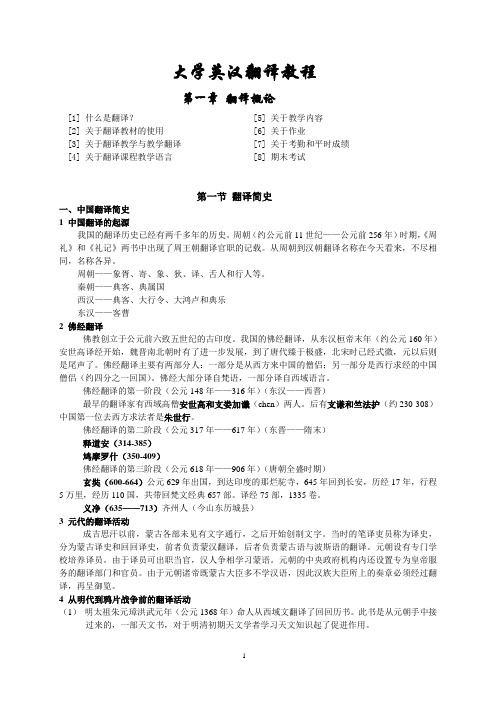
大学英汉翻译教程第一章翻译概论[1]什么是翻译?[2]关于翻译教材的使用[3]关于翻译教学与教学翻译[4]关于翻译课程教学语言[5]关于教学内容[6]关于作业[7]关于考勤和平时成绩[8]期末考试第一节翻译简史一、中国翻译简史1 中国翻译的起源我国的翻译历史已经有两千多年的历史。
周朝(约公元前11世纪——公元前256年)时期,《周礼》和《礼记》两书中出现了周王朝翻译官职的记载。
从周朝到汉朝翻译名称在今天看来,不尽相同,名称各异。
周朝——象胥、寄、象、狄、译、舌人和行人等。
秦朝——典客、典属国西汉——典客、大行令、大鸿卢和典乐东汉——客曹2 佛经翻译佛教创立于公元前六致五世纪的古印度。
我国的佛经翻译,从东汉桓帝末年(约公元160年)安世高译经开始,魏晋南北朝时有了进一步发展,到了唐代臻于极盛,北宋时已经式微,元以后则是尾声了。
佛经翻译主要有两部分人:一部分是从西方来中国的僧侣;另一部分是西行求经的中国僧侣(约四分之一回国)。
佛经大部分译自梵语,一部分译自西域语言。
佛经翻译的第一阶段(公元148年——316年)(东汉——西晋)最早的翻译家有西域高僧安世高和支娄加谶(chen)两人。
后有支谦和竺法护(约230-308)中国第一位去西方求法者是朱世行。
佛经翻译的第二阶段(公元317年——617年)(东晋——隋末)释道安(314-385)鸠摩罗什(350-409)佛经翻译的第三阶段(公元618年——906年)(唐朝全盛时期)玄奘(600-664)公元629年出国,到达印度的那烂驼寺,645年回到长安,历经17年,行程5万里,经历110国,共带回梵文经典657部。
译经75部,1335卷。
义净(635——713)齐州人(今山东历城县)3 元代的翻译活动成吉思汗以前,蒙古各部未见有文字通行,之后开始创制文字。
当时的笔译吏员称为译史,分为蒙古译史和回回译史,前者负责蒙汉翻译,后者负责蒙古语与波斯语的翻译。
元朝设有专门学校培养译员。
中国翻译简史
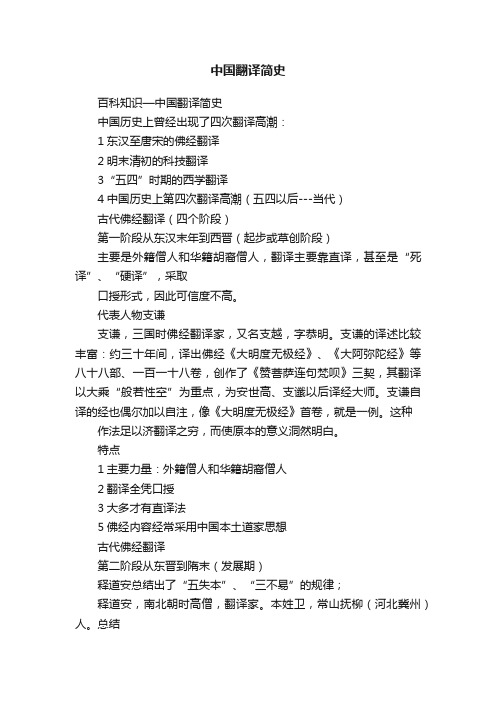
中国翻译简史百科知识—中国翻译简史中国历史上曾经出现了四次翻译高潮:1东汉至唐宋的佛经翻译2明末清初的科技翻译3“五四”时期的西学翻译4中国历史上第四次翻译高潮(五四以后---当代)古代佛经翻译(四个阶段)第一阶段从东汉末年到西晋(起步或草创阶段)主要是外籍僧人和华籍胡裔僧人,翻译主要靠直译,甚至是“死译”、“硬译”,采取口授形式,因此可信度不高。
代表人物支谦支谦,三国时佛经翻译家,又名支越,字恭明。
支谦的译述比较丰富:约三十年间,译出佛经《大明度无极经》、《大阿弥陀经》等八十八部、一百一十八卷,创作了《赞菩萨连句梵呗》三契,其翻译以大乘“般若性空”为重点,为安世高、支谶以后译经大师。
支谦自译的经也偶尔加以自注,像《大明度无极经》首卷,就是一例。
这种作法足以济翻译之穷,而使原本的意义洞然明白。
特点1主要力量:外籍僧人和华籍胡裔僧人2翻译全凭口授3大多才有直译法5佛经内容经常采用中国本土道家思想古代佛经翻译第二阶段从东晋到隋末(发展期)释道安总结出了“五失本”、“三不易”的规律;释道安,南北朝时高僧,翻译家。
本姓卫,常山抚柳(河北冀州)人。
总结了汉代以来流行的佛教学说,整理了新译旧译的经典,编纂目录,确立戒规,主张僧侣以“释”(释迦牟尼)为姓。
主要监督翻译了《四阿含》等。
主张直译,不增不减,只做词序调整。
翻译佛经在五种情况下会失去本来面目,有三件事决定了译事是很不容易的,因此必须慎之又慎。
彦琮在其论着《辩正论》中提出了翻译要例“十条和对译者的要求“八备””彦琮(557—610年),俗姓李,邢台隆尧县双碑人,隋代著名高僧,他精通梵文,也是我国佛教史上屈指可数的佛经翻译家和佛教著作家。
《辩正论》里翻译要例八备十条:就是对做翻译人的具体要求和翻译要求。
鸠摩罗什开始提倡意译;鸠摩罗什(梵语Kumārajīva )(公元344 ~ 413 年),音译为鸠摩罗耆婆,又作鸠摩罗什婆,简称罗什。
其父名鸠摩罗炎,母名耆婆,属父母名字的合称,汉语的意思为“童寿”。
《中国翻译简史》(五四以前部分)述评
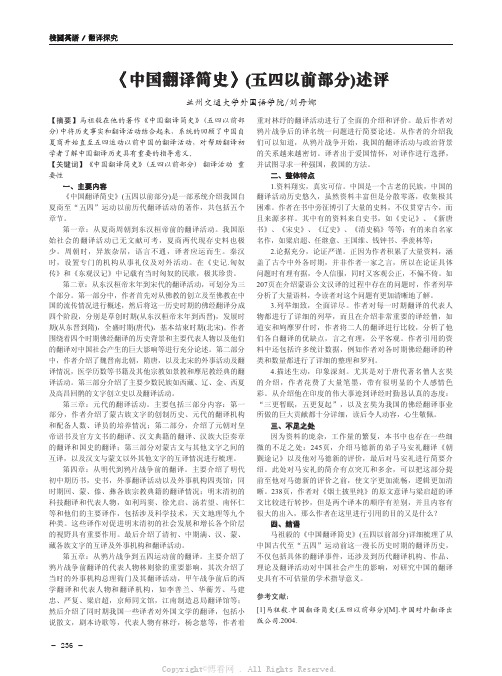
- 236-校园英语 / 翻译探究《中国翻译简史》(五四以前部分)述评兰州交通大学外国语学院/刘丹娜【摘要】马祖毅在他的著作《中国翻译简史》(五四以前部分)中将历史事实和翻译活动结合起来,系统的回顾了中国自夏商开始直至五四运动以前中国的翻译活动,对帮助翻译初学者了解中国翻译历史具有重要的指导意义。
【关键词】《中国翻译简史》(五四以前部分) 翻译活动 重要性一、主要内容《中国翻译简史》(五四以前部分)是一部系统介绍我国自夏商至“五四”运动以前历代翻译活动的著作,共包括五个章节。
第一章:从夏商周朝到东汉桓帝前的翻译活动。
我国原始社会的翻译活动已无文献可考,夏商两代现存史料也极少。
周朝时,异族杂居,语言不通,译者应运而生。
秦汉时,设置专门的机构从事礼仪及对外活动。
在《史记.匈奴传》和《东观汉记》中记载有当时匈奴的民歌,极其珍贵。
第二章:从东汉桓帝末年到宋代的翻译活动,可划分为三个部分。
第一部分中,作者首先对从佛教的创立及至佛教在中国的流传情况进行概述,然后将这一历史时期的佛经翻译分成四个阶段,分别是草创时期(从东汉桓帝末年到西晋),发展时期(从东晋到隋),全盛时期(唐代),基本结束时期(北宋)。
作者围绕着四个时期佛经翻译的历史背景和主要代表人物以及他们的翻译对中国社会产生的巨大影响等进行充分论述。
第二部分中,作者介绍了魏晋南北朝,隋唐,以及北宋的外事活动及翻译情况,医学历数等书籍及其他宗教如景教和摩尼教经典的翻译活动。
第三部分介绍了主要少数民族如西藏、辽、金、西夏及高昌回鹘的文字创立史以及翻译活动。
第三章:元代的翻译活动。
主要包括三部分内容:第一部分,作者介绍了蒙古族文字的创制历史、元代的翻译机构和配备人数、译员的培养情况;第二部分,介绍了元朝对皇帝诏书及官方文书的翻译、汉文典籍的翻译、汉族大臣奏章的翻译和国史的翻译;第三部分对蒙古文与其他文字之间的互译,以及汉文与蒙文以外其他文字的互译情况进行梳理。
中国翻译简史
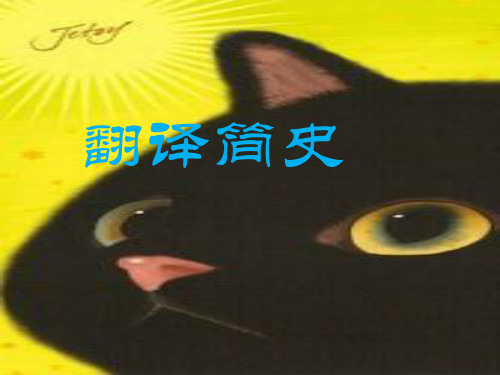
新 中 国 成 立 至 今
西方翻译简史(2000年的翻译史)
古代西方翻译史 中世纪西方翻译 文艺复兴时期的西方翻译
近代法国翻译 近代德国翻译 近代英国翻译 近代俄国翻译
近代西方翻译
现代西方翻译
西方翻译史于公元前三世纪揭开它的第一页。广义上说西方最早 的译作是公元前三至二世纪,72名犹太学者在埃及亚历山大城翻译 的《圣经· 旧约》(Old testament),即《七十子希腊文本》(The Septuagint),它开创了翻译集体合作的先河。严格意义上说有文字 记载的西方第一部译作是在约元前三世纪中叶安德罗尼柯在罗马用 拉丁语翻译的希腊荷马史诗《奥德赛》。 里维乌斯.安德罗尼柯(Livius Andronicus)、涅维乌斯(Gnaeus Naevius)和恩尼乌斯(Quintus Ennius)并称罗马文学三大鼻祖。普劳图 斯(Plautus)、泰伦斯(Terence)、西方最早的理论翻译家西塞罗 (Marcus Tullius Cicero)、贺拉斯(Quintus Horatius Flaccus)、昆体良 (Marcus Fabius Quintilianus) 哲罗姆(St. Jerome)的《通俗拉丁文本圣经》 奥古斯丁(St. Augustone) 这是欧洲也是整个西方历史上第一次大规模的翻译活动,其历史 功绩在于:——它开创了翻译的局面,把古希腊文学特别是戏剧介 绍到了罗马,促进了罗马文学的诞生和发展,对于罗马以至日后西 方继承古希腊文学起到了重要的桥梁作用。 罗马帝国后期,宗教翻译取代了日渐衰落的文学翻译,并形成了 西方翻译史上的第二个高潮,这一时期,最有影响的翻译家当属哲 罗姆和奥古斯丁。 随着罗马帝国的衰落,西方的翻译也逐渐转入低潮,而过渡到中 世纪。
五 四 时 期
- 1、下载文档前请自行甄别文档内容的完整性,平台不提供额外的编辑、内容补充、找答案等附加服务。
- 2、"仅部分预览"的文档,不可在线预览部分如存在完整性等问题,可反馈申请退款(可完整预览的文档不适用该条件!)。
- 3、如文档侵犯您的权益,请联系客服反馈,我们会尽快为您处理(人工客服工作时间:9:00-18:30)。
Chapter1中国翻译简史Three peaks of translation in history1)the translation of Buddhist classics: the first peak支谦,鸠摩罗什,真谛,玄奘2)the translation of books on science and technology: the second peak徐光启(科学译祖),李之藻3)the translation of western classics: the third peak1,严复信faithfulness,意义不背原文达expressiveness,不拘泥于原文的形式,以最准确、最生动的译文把原文的意思表达出来雅elegance,译文本身的古雅《天演论》《法意》《原富》《名学》》《群己权界论》2,梁启超学术界的鸿儒用资产阶级思想方法研究中国历史3,林纾儆醒人心,反帝救国;开创中国翻译事业的先行者和奠基人《巴黎茶花女遗事》,《王子复仇记》Translation in contemporary China: from 1919 to 19494, 鲁迅对中国近代文学翻译史的重要贡献(一)开辟了近代中西文化交流史上具有重要意义和影响的第二潮流(二)我国近代翻译史上的重大变革翻译思想(一)“易解、丰姿”双重标准(二)“以直译为主,意译为辅”与“以信为主,以顺为辅”5,瞿秋白大众化原则,“绝对正确,绝对白话文”的思想翻译《国际歌》6,郭沫若重译家责任, 重视译者主体性;强调的翻译动机7,林语堂翻译是一门艺术;翻译的标准:忠实、通顺和美8,朱光潜西方美学翻译Translation in contemporary China: from 1949 to the present time9, 茅盾“神韵说”;创造性翻译论10,傅雷神似说强调原文精神和韵味的重现11,钱钟书化境论,强调译者流畅、地道的本族语12,王佐良以诗译诗;为读者着想, 译文要可靠、可读13,许渊冲美化之艺术﹑创优似竞赛;文学翻译是艺术;以诗译诗;贯彻再创作论春眠不觉晓,处处闻啼鸟。
夜来风雨声,花落知多少。
This morn of spring in bed I’m lyi ng,Not woke up till I hear birds crying.After one night of wind and showers,How many are the fallen flowers.Chapter 2 翻译的标准、过程及对译作的要求一,翻译的标准:忠实、通顺忠实,指忠实于原作的内容,保持原作的风格;是翻译标准中的首要问题,它对原作的内容、风格、语言应有全面的照顾。
通顺,指译文语言必须通顺易懂,符合规范;二者相辅相成。
二,翻译的过程:理解、表达、校核直译和意译literal translation and free translation1, what the tongue says, the neck pays for.直译:舌头说话,脖子还账。
意译:舌头闯祸,脖子遭殃。
2,A gift is a key to open the door closed against you.直译:礼物是打开把你关在门外的房门的钥匙。
意译:大门把你关在外,礼物送到门自开。
直译不等于字对字的翻译,否则容易闹类似下面的出笑话:How are you? 怎么是你?How old are you? 怎么老是你?人山人海People mountain people sea●Chinese dragon●American beauty●pull one's leg●pull up one‘s socks●You can say that again!●It has been 4 years since I smoked. 我戒烟4年了。
(不是“我抽烟4年了”)●black strangerwhite man3,there is no pot so ugly it can’t find a lid.直译:再丑的罐儿,也不愁配个盖儿。
意译:再丑的姑娘也不愁找不到婆家。
或,丑女不愁嫁。
4,little fish does not eat big fish.直译:小鱼吃不了大鱼。
意译:胳膊拧不过大腿。
翻译的定义翻译是指把一种语言文字的意义转换成另一种语言文字。
简言之,翻译是一种用不同的语言文字将原文作者的意思准确地再现出来的艺术。
从以上定义我们知道,原文的意思必须尽可能得到保持,不可有所增删。
译者的任务只是转换文字,而不是改变其意思。
因此,翻译有两要素:准确性与表达性。
准确性是翻译的首要条件。
译者必须谨慎地遵循原作者的意思,所选用的字句和句式结构必须如实地传达出原文的思想。
表达性是让译文易于理解。
换言之,译者必须用自己的手段尽可能地将原文的思想清楚而有力地表达出来。
准确性使译出的思想明确无误,而表达性则使译文生动,具有魅力。
A translator should give a complete transcript of the ideas of the original work. The style and manner should be of the same character as that of the original. A translation should have all the ease of the original composition.A.F. Tyler—Essay on the principles of translationTranslation consists in reproducing in the receptor language the closest natural equivalent of the source language, first in terms of meaning and secondly in terms of style.Eugene Nida—The theory and practice of translation这两个定义都提到,在翻译转换过程中,不仅要实现意义的忠实再现,而且在风格上要与原文接近。
eg.1, Good to the last drop.滴滴香浓,意犹未尽。
2,The dew drops, the peony sips with open mouth.露滴牡丹开。
3,无边落木萧萧下,不尽长江滚滚来。
The boundless forests sheds its leaves shower by shower, the endless river rolls its waves hour after hour.4, 不爱红妆,爱武装。
They love to face the powder than to powder the face.5,What’s on your arm should be as beautiful as who’s on it.一表在腕,美如其(伊)人。
好马配好鞍,靓表配俊男。
三,合格译员的要求:1,具有扎实的双语基础;2,广博的知识;3,专业素质和专业态度;4,掌握一定的翻译理论和技巧。
经典翻译赏析1, The Romance of the Three KingdomThe Tale of Water MarginThe Pilgrimage to the WestDream of Red Mansion2,BMW(汽车)宝马汽车品牌BMW全称为“Bayerische Motoren Werke”(巴伐利亚汽车制造厂),原商标名在源语里除提供商品来源信息外,没有其他涵义。
但是根据原语商标名中的“B”和“M”的读音翻译成的“宝马”,使中国消费者产生美好联想:现代的名车好比古代的宝马,而在古代,宝马是极其珍贵的。
杜甫在《房兵曹胡马诗》中赞颂的“竹批双耳峻,风入四蹄轻。
所向无空阔,真堪托死生。
骁腾有如此,万里可横行”,多么令人羡慕。
“宝马”也可能令人想起辛弃疾的经典之作《青玉案》中的名句“宝马雕车香满路”,万俟咏《昭君怨》中的“香车宝马,谢他酒朋诗侣”和《三台》中的“向晚骤、宝马雕鞍,醉襟惹、乱花飞絮”。
同时,在厂家的宣传中,“宝马”被说成是“具有速度的飙悍的座驾”。
意境美妙绝伦的名称,加上厂家的着力宣传,消费者不动心也难。
3,红豆(服装)Love Seed说起“红豆”,人们可能不禁想起唐代诗人王维写下“红豆生南国,春来发几枝。
愿君多采撷,此物最相思”的千古绝唱。
“红豆”在中国有着丰富而深刻的文化意蕴,多少人以此为题吟诗作对,多少人特赠此物寄托相思。
同时,红色是中国文化中的基本崇尚色,它体现了中国人在精神和物质上的追求,象征着吉祥和喜庆。
“豆”又指种子,具有极强的生命力。
“红豆”和制衣联在一起,提高了产品的文化内含,推至海外用“Love Seed”(爱的种子)而不用“Red Bean”以示爱心。
现在,这颗“爱的种子”已经生根发芽,开花结果。
“奉献红豆爱意”的独特营销文化,使红豆集团公司大大提高了知名度和美誉度(黄得莲,1998)。
4,Poison(香水)百爱神Poison在英语中的意思是“毒物”、“毒药”、“毒害”,它是为迎合一些女性追求野性、粗鄙的异国风情而设计的。
商标名暗示着该香水有非凡之处,能使女性妖艳迷人,成为“红颜祸水”,产品因此受到不少西方国家女性的青睐,销售情况一直较好。
但把它引进中国市场,如果照字面意思直译,便很难让受传统文化教育的中国女性接受。
所以,在翻译时,译者把这个商标名音译为“百爱神”。
“百爱神”,众爱之神也,寓意优雅,魅力无穷。
这一翻译顺应了中国的文化习惯,自然被中国消费者接受。
5, Benz(汽车)奔驰世界名牌汽车Benz是根据德国机械工程师、世界第一辆内燃机汽车的设计和制造者的名字命名的。
Benz在香港最初译为“本茨”,后来被“平治”取代;在台湾译为“朋驰”。
无论是“平治”还是“朋驰”,都不如大陆所译的“奔驰”那么音美、意美,那么有助于销售。
“奔驰”既与英文Benz语音接近,清脆响亮,又突出了汽车的特性,显得豪迈,让人领略到该车风驰电掣、快捷如飞的雄姿,实属上乘之作。
6,Clean & Clear(护扶品)可伶可俐护扶品“可伶可俐”在中国大受欢迎,特别畅销,不能不说这一译名起了不少作用。
“伶俐”,“聪明、灵巧”之谓,又含“清晰、干净”之意。
译名可传达这样的信息:本护扶品不仅可使你的皮肤变得清透净白,而且能提升你的精神,使你显得聪明灵巧,惹人羡慕。
